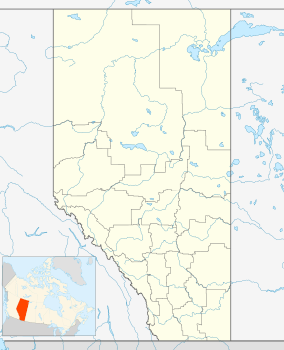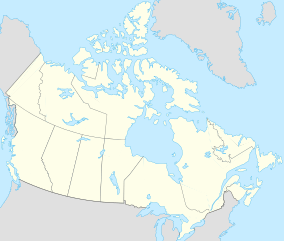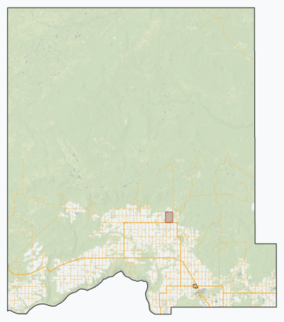Chinchaga Wildland Provincial Park facts for kids
Quick facts for kids Chinchaga Wildland Provincial Park |
|
|---|---|
|
IUCN Category Ib (Wilderness Area)
|
|
| Location | Clear Hills County, Alberta, Canada |
| Nearest town | Manning |
| Area | 80,270 ha (309.9 sq mi) |
| Established | 15 December 1999 |
| Governing body | Alberta Tourism, Parks and Recreation |
Chinchaga Wildland Provincial Park is a special protected area in northwestern Alberta, Canada. It's like a huge natural playground, covering about 800 square kilometers (309 square miles) of land. This park is part of a much bigger wilderness area called Chinchaga, which is about 5,000 square kilometers (1,930 square miles). The park was created on December 15, 1999, to protect its unique environment.
Contents
Where is Chinchaga Park?
The park is located in Clear Hills County in northwestern Alberta. It's quite far from towns, about 100 kilometers (62 miles) west of Manning. It's also very close to the border with British Columbia.
The Chinchaga River forms the northern edge of the park. To the south, you'll find the slopes of Halverson Ridge. The land in the park goes from less than 700 meters (2,300 feet) high near the river to over 1,050 meters (3,440 feet) at the top of Halverson Ridge. This park is very remote, meaning it's hard to get to, and there are no official roads inside it.
A Look Back: History of the Area
For a long time, the Chinchaga area was mainly used by small groups of First Nations and Métis people for hunting.
The Huge Chinchaga Fire of 1950
In the spring of 1950, the Chinchaga River area was very dry. On June 1, 1950, a forest fire started, likely caused by human activity. This fire became one of the largest in modern North American history!
The fire started north of Fort St. John, British Columbia. It burned northeast, almost reaching Keg River, Alberta. The fire kept burning all summer and into the fall, finally stopping at the end of October. It destroyed a massive area, about 10,000 square kilometers (3,860 square miles) of the Chinchaga wilderness. Later studies showed the burned area was even larger, around 17,000 square kilometers (6,560 square miles). This fire created the biggest burned area ever recorded on the continent.
Protecting the Area
In 1997, a report said that the Chinchaga area and river were very important for the environment. Then, in 1999, a special committee suggested that Canada should do more to protect its boreal forests.
In 2000, the Alberta government started a program called "Special Places." The goal was to protect natural areas like Chinchaga. However, some groups felt that the protected part of Chinchaga was too small. They pointed out that only about 800 square kilometers (309 square miles) of the 5,000 square kilometers (1,930 square miles) of wilderness were protected. They also worried about activities like oil and gas exploration happening in other parts of the wilderness area.
Nature and Wildlife
Chinchaga Wildland Park is a great example of the Boreal Forest in Alberta. It has many different types of landscapes and plants.
What's the Weather Like?
The park has a subarctic climate. This means it has long, cold winters and short, warm to cool summers. For example, temperatures are usually above 10°C (50°F) only in June, July, and August. From November to March, it's usually below 0°C (32°F). The wettest months are June and July, with lots of rain.
Animals and Plants
The park is a mix of boreal forests and muskeg (a type of swampy land). You'll find both deciduous trees (that lose their leaves) and coniferous trees (like pines and spruces). There are also many wetlands and fens (another type of wet, marshy land).
This diverse environment is home to many amazing animals, including:
- Woodland caribou (Rangifer tarandus)
- Trumpeter swan (Cygnus buccinator)
- Grizzly bear (Ursus arctos)
These three animals are especially important in the park. Other animals you might find include:
- Beaver (Castor canadensis)
- Northern goshawk (Accipiter gentiles)
- Muskrat (Ondatra zibethicus)
- Marten (Martes americana)
- Fisher (Martes pennant)
- Moose (Alces alces)
- Wolf (Canis lupus)
- Lynx (Lynx canadensis)
- Pileated woodpecker (Dryocopus pileatus)
There are also many other small mammals, furbearers, raptors, songbirds, and waterfowl living in the park.
Protecting Woodland Caribou
The park is part of the home range for the Chinchaga herd of woodland caribou. These caribou are considered "at risk" because their numbers are low. They are listed as "threatened" in Alberta.
Woodland caribou need very large areas to live, especially for having their babies and for winter. Their habitat often goes beyond the park's current borders. Experts have suggested that areas outside the park that are important for caribou should also be protected and managed carefully.




